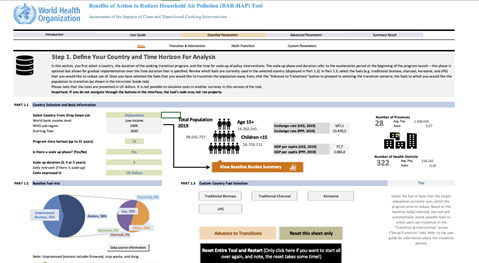Benefits of Action to Reduce Household Air Pollution (BAR-HAP) Tool (Version 2, July 2021)
Excel Tool

Overview
The Benefits of Action to Reduce Household Air Pollution (BAR-HAP) tool is a planning tool for assessing the costs and benefits of different interventions that aim to reduce cooking-related household air pollution. BAR-HAP is a resource in WHO’s Clean Household Energy Solutions Toolkit (CHEST). The tool includes 16 different cleaner cooking transitions from more polluting stoves and fuels to cleaner options, including both transitional options (that offer some health benefits) and clean options (that meet emissions levels in the WHO Guidelines for indoor air quality: household fuel combustion). For each cooking transition, users can also select a policy intervention that will be applied, such as stove or fuel subsidy, financing, intensive behavior change campaign, or a technology ban.
BAR-HAP is a strategic tool for medium-term planning (over a period of 30 years) that can be used to a) generate forecasts of financial resource needs at the national (or sub-national) level, and b) compare those resource needs with the value of the net benefits that the transitions entail. The tool is useful for improving budgeting in health, energy and other sectors; informing development agencies about resources needed to tackle HAP; and engaging with government and civil society constituencies.
